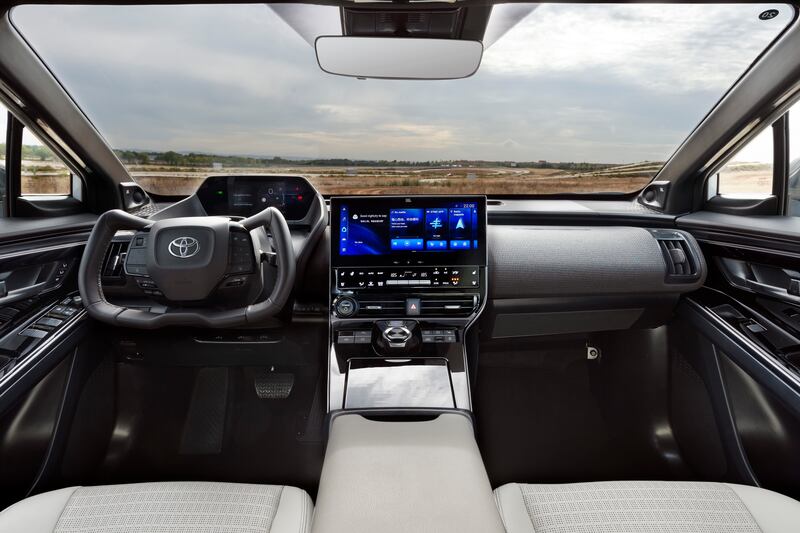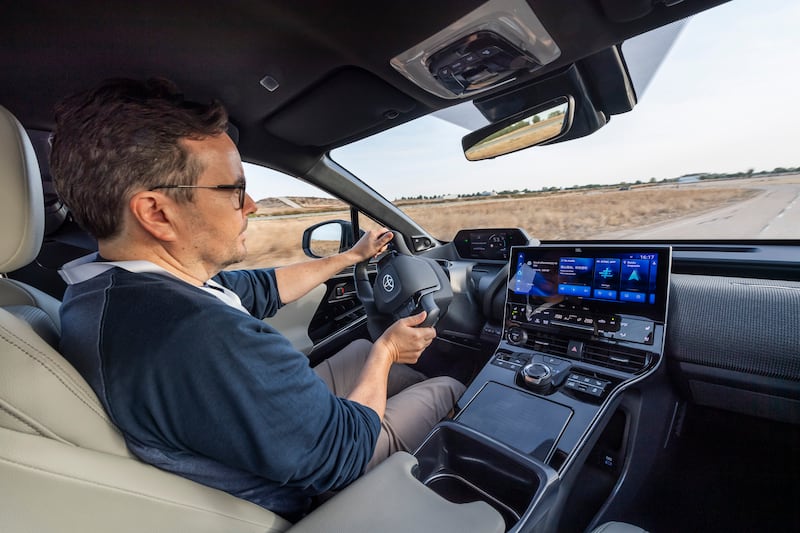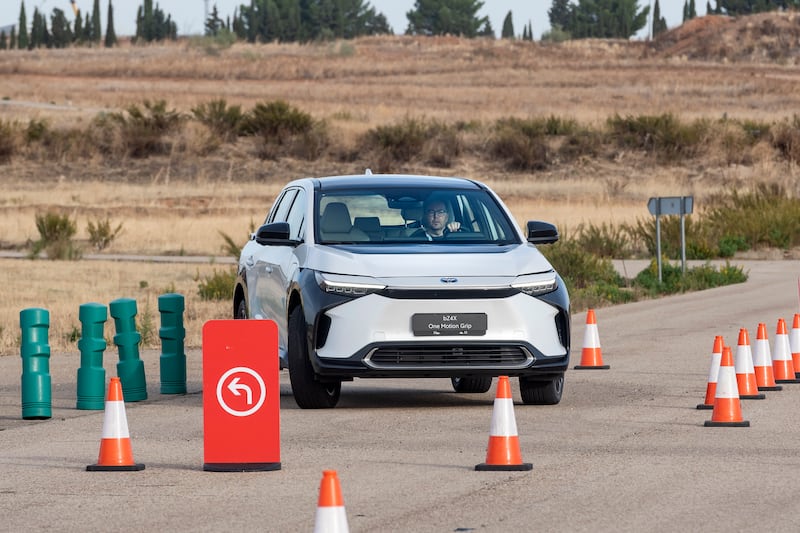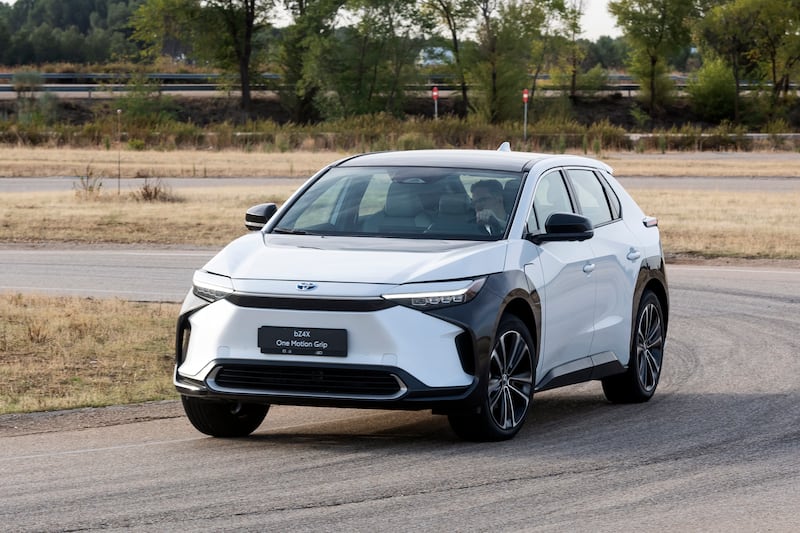It’s worth a bet that the car world’s biggest talking point by the end of 2023 will be not electric vehicles but the arrival of the yoke.
Elon Musk may have hoped you got a grip of his yoke first, but it’s likely to be a Japanese yoke that most Irish motorists will handle first. Toyota is late to the all-electric car revolution, but its new BZ4X hopes to be in the lead on another automotive upheaval. Out goes the steering wheel and in comes a dual-handled hub that changes not only how we control the front wheels but also, perhaps, even where the driver sits.
Of course, as radical as it seems inside a Toyota, the yoke is not new to the world of vehicles. Pilots are well used to them, as are many sailors and even Formula 1 drivers. But that’s hardly comparable to a family SUV on a school run. The yoke might lend itself to lightning-fast turns on a racetrack, but that sort of reaction might be a little too direct for the shopping centre car park.
That this new tech arrives not on a Porsche or Tesla but on a Toyota will rightly raise a few eyebrows. Admittedly, Tesla has a yoke of its own in the works, but, unlike that system, Toyota’s is not simply bolted on to a conventional steering column. Instead this is One Motion Grip steer-by-wire. Your hand movements on the yoke are translated into movements of the front wheels completely by electric signals and wires.
RM Block

As with modern power steering systems, the steering ratios and feedback adjust to speed and steering angle, but here all sensations are electronically created, so any feel from the road is via algorithm.
The entire turning circle is 150 degrees lock-to-lock, so your hands never need to leave the quarter-to-three position. It means no more hand-over-hand arms movements in tight turns.
It may seem akin to what you get on some driving game simulators these days, but it’s one thing to screw up a bend and stuff a simulated car into a stone wall, another when it’s your family motor.

The big question, of course, is what Toyota’s yoke is like to drive. Remarkably, it’s pretty natural from the start. As you pull away from a parking space, it doesn’t turn the car into an errant shopping trolley. Instead, it eases out into its lane and rolls through the initial sweeping bends of our test track route remarkably well.
Within a matter of seconds, the brain recalibrates the sense of feel and movement; it’s the eyes and years of in-built learned experience that calls the whole thing into question. Yet, even for this middle-aged motoring hack the speed of adoption is surprising.
A gentle turn in sweeping bends is easy, but what impresses is that rapid changes in speed do not upset the ratios into creating too much or too little turn.
The benefit of the test track route was that we could repeat the same corners not only at different speeds but also with the same BZ4X fitted with a regular steering wheel.
The biggest difference was showcased on a ridiculously tight autocross section of the test track. With the regular wheel, there were the predictable flailing elbows but with the yoke at slow speeds it took the merest of touches to twist the car through the cones.
The issue with the yoke is over-turning. At slow speeds, where the steering weight can also feel over-heavy, your hands never leave the yoke but if you really need to be wary of just how sharp a turn the car is making. On right-hand bends marked out with cones, the damage is negligible; in a car park or city street with cyclists, it will be more serious.

Even after three runs through the coned autocross circuit, I was still coming to grips with how tightly the car was hugging the apex, and compensating by going slightly wider into the bends. No doubt you will get to grips with it after a while, but it may cost you a few dents on your rear doors.
Aside from the overly-weighted feel at crawling speed, the yoke was little different to the regular steering wheel in terms of its sense of feedback. Clearly, a Toyota SUV’s steering wouldn’t be a benchmark for delivering a sense of the tarmac through the driver, but there’s nothing terribly remote about the yoke.
As we know from the simulator games, the trick with digital systems these days is that they can dial in the level of feel you need, whether its neutral point-and-click or the sensation of every pebble on the road.
The real revolution is uncoupling the yoke from the front wheels. The signal from the yoke directs a motor acting on the steering rack while a second motor returns feedback and vibration to the yoke.
The system starts with the driver’s input in terms of turning the yoke and the speed of that turn but then crunches a myriad of other data including the vehicle’s speed, the crosswinds and angle of the road before crunching the data and sending the necessary instructions to the front wheels.

The decision to attach these electronics to a yoke rather than a regular steering wheel comes from years of testing. By limiting the movement to 150 degrees, and effectively fixing the location of the driver’s hands, the system has a much greater understanding of the degree of turn being requested.
As to the inevitable question about what happens when things go wrong, Toyota BZ4X chief engineer Daisuke Ido points to back-up solutions all the main elements including power supply that will allow up to 24 turns after a component fails. They also point to the fact the system has been approved by EU safety regulators.
While it won’t save the planet, or change the very nature of car ownership in the same way EVs hope to, clearly it’s going to be a pretty major shift for many motorists, on a par with opting for automatic over manual.
Driving an EV requires little change in what we do behind the wheel: this may take a little more time to get used to, but it will ultimately bring hands-free driving and even fully autonomous driving closer to reality.
The yoke opens up a lot more possibilities for car designers: with steer-by-wire joining brake-by-wire and drive-by-wire throttles, it’s not inconceivable that it will make conversions of left- and right-hand drive vehicles much easier, perhaps even a feature. In the world of automotive fantasy you could even let the back-seat driver take the wheel for a while.
From our time testing it against its full-circle alternative, we can see the benefit it can deliver. What we really need to see is some yokes directing more tail-happy sports cars to get the real benefit of that short input and quick response.
Toyota isn’t forcing this new tech on anyone: it will be offered as an option on the BZ4X from this time next year and on its premium sibling the Lexus RZ450e. And for some, it will clearly be a step too far. But then, they said the same about EVs, power steering and ABS to name but three.
My inner Luddite screams this simply shouldn’t work, but first impressions are that it does and just like so many other automotive innovations it may well become standard fare pretty quickly.



















